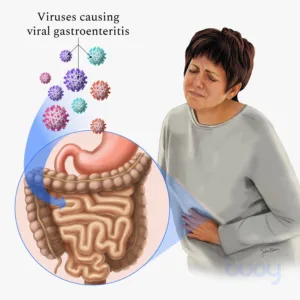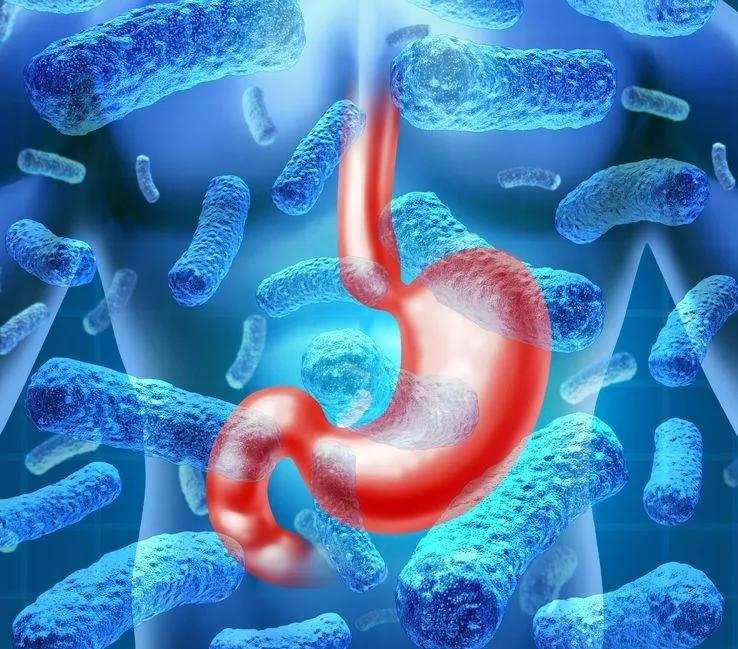Gastroenteritis: Causes, Symptoms, and Treatment
Gastroenteritis, commonly known as gastritis, is a condition characterized by inflammation of the stomach and intestines. It is a common gastrointestinal disorder that can cause discomfort and disrupt daily activities. Within this informative piece, we shall delve into the origins, indications, and possible remedies concerning gastritis.
Definition:
Gastroenteritis, also known as gastritis, is a condition that involves inflammation of the stomach and intestines. This prevalent gastrointestinal ailment impacts individuals of various age groups, making it a widespread disorder. Gastritis can be caused by various factors, including bacterial infections, viral infections, parasitic infections, and food poisoning.
Causes of Gastroenteritis
Bacterial Infections
Bacterial infections such as Helicobacter pylori (H. pylori) are one of the leading causes of gastritis. These bacteria can invade the stomach lining and cause inflammation. Other bacteria, such as Salmonella and Escherichia coli (E. coli), can be contracted through contaminated food or water, leading to gastroenteritis.
Viral Infections
Viral infections, particularly norovirus and rotavirus, are common causes of gastroenteritis. These viruses are highly contagious and can spread through close contact with infected individuals or by consuming contaminated food or water. Viral gastroenteritis is often characterized by sudden onset symptoms and can cause outbreaks in community settings.

Parasitic Infections
Parasites like Giardia lamblia and Cryptosporidium can also cause gastroenteritis. These parasites are typically found in contaminated water sources and can cause severe diarrhea and abdominal discomfort.
Food Poisoning
Consuming contaminated food or beverages can lead to food poisoning and subsequent gastroenteritis. Bacterial toxins, such as those produced by Staphylococcus aureus and Clostridium perfringens, can cause rapid-onset symptoms, including nausea, vomiting, and diarrhea.
Symptoms of Gastroenteritis
Gastroenteritis is associated with a range of symptoms that can vary in severity. The common symptoms include:
Nausea and Vomiting
Nausea and vomiting are common early signs of gastroenteritis. These symptoms are often accompanied by a loss of appetite and a general feeling of unease.
Diarrhea
Diarrhea is a prevalent symptom of gastroenteritis. It is characterized by loose or watery stools and can lead to dehydration if not managed properly.
Abdominal Pain
Abdominal pain and cramping are common complaints in individuals with gastritis. The pain is often located in the lower abdomen and can range from mild to severe.
Fever and Chills
In some cases, gastroenteritis can be accompanied by a fever and chills. These symptoms typically indicate an underlying infection.
Diagnosis of Gastroenteritis: A Comprehensive Guide
Gastroenteritis is a common gastrointestinal disorder characterized by inflammation of the stomach and intestines. It is often caused by viral or bacterial infections and can result in symptoms such as diarrhea, vomiting, abdominal pain, and fever. To accurately diagnose gastroenteritis, healthcare professionals employ various diagnostic techniques, including physical examination, medical history assessment, and stool sample analysis. In this article, we will explore each of these diagnostic methods in detail, shedding light on their significance in identifying and treating gastroenteritis.
1. Physical Examination
A thorough physical examination plays a crucial role in diagnosing gastroenteritis. During the examination, the healthcare provider evaluates the patient’s overall condition and looks for specific signs and symptoms associated with the illness. The physical examination may include the following assessments:
Observation of Vital Signs
The healthcare provider will measure the patient’s vital signs, including body temperature, heart rate, and blood pressure. Elevated temperature and increased heart rate may indicate an infection.
Abdominal Palpation
Palpating the abdomen allows the healthcare provider to assess tenderness, distention, or other abnormalities. In gastroenteritis, the abdomen may be tender and bloated.
Evaluation of Hydration Status
Gastroenteritis can lead to dehydration due to excessive fluid loss. The healthcare provider will assess the patient’s skin turgor, mucous membranes, and urine output to determine their hydration status.
2.Medical History
Obtaining a comprehensive medical history is essential for an accurate diagnosis of gastroenteritis. The healthcare provider will ask the patient various questions to gather information about their symptoms, recent activities, and possible risk factors. Some key aspects of the medical history assessment include:
Symptoms Description
The patient will be asked to describe their symptoms in detail, including the duration and severity of diarrhea, vomiting, abdominal pain, and fever. This information helps in distinguishing gastroenteritis from other similar conditions.
Recent Food Intake
The healthcare provider will inquire about the patient’s recent food intake, paying attention to any potential exposure to contaminated food or water sources. This is crucial in identifying potential bacterial causes of gastroenteritis, such as Salmonella or E. coli.
Travel History
If the patient has recently traveled to a foreign country, the healthcare provider will consider the possibility of acquiring a travel-related infection. This information aids in narrowing down the potential causes of gastroenteritis.
3.Stool Sample Analysis
Stool sample analysis is a vital diagnostic tool used to identify the underlying cause of gastroenteritis. The patient is requested to provide a stool sample, which is then examined in a laboratory. The analysis may include the following:
Microscopic Examination
The stool sample is examined under a microscope to identify any parasites, bacteria, or yeast that might be causing the infection. This analysis helps in determining the appropriate treatment.
Culture and Sensitivity Testing
In some cases, a culture and sensitivity test is performed to isolate the specific bacteria responsible for the infection. This test helps in guiding the selection of an appropriate antibiotic for treatment.
Polymerase Chain Reaction (PCR)
PCR testing is a highly sensitive method used to detect viral DNA or RNA in the stool sample. It is particularly useful in identifying viral causes of gastroenteritis, such as norovirus or rotavirus.
To diagnose gastroenteritis, a healthcare professional will perform a physical examination and inquire about the patient’s medical history. In some cases, a stool sample analysis may be required to identify the causative agent, especially when bacterial or parasitic infections are suspected.
Treatment of Gastroenteritis: Fluid Replacement, Medications, Dietary Changes, Rest, and Hygiene
Gastroenteritis, commonly known as the stomach flu, is an inflammation of the gastrointestinal tract. It is typically caused by a viral or bacterial infection and can lead to symptoms such as diarrhea, vomiting, abdominal pain, and dehydration. While gastroenteritis can be unpleasant and disruptive to daily life, proper treatment can help alleviate symptoms and promote a quicker recovery. In this article, we will explore the various treatment options for gastroenteritis, including fluid replacement, medications, dietary changes, rest, and hygiene.
1.Fluid Replacement
One of the most important aspects of treating gastroenteritis is ensuring proper fluid replacement. The excessive fluid loss through vomiting and diarrhea can quickly lead to dehydration, especially in children and the elderly. It is crucial to replenish lost fluids to maintain hydration levels and support the body’s healing process.
Importance of Fluids
Drinking an adequate amount of fluids is essential during a bout of gastroenteritis. Water, diluted fruit juices, and electrolyte-rich beverages can help replace lost fluids and electrolytes. It is advisable to sip small amounts of fluids frequently rather than consuming large quantities at once.
Oral Rehydration Solution (ORS)
Oral rehydration solutions, such as Pedialyte or Gatorade, are specifically formulated to replenish lost fluids and electrolytes. These solutions contain the right balance of salt, sugar, and water, making them highly effective in treating dehydration caused by gastroenteritis. ORS is available in pharmacies and can be taken in small, frequent sips.
Clear Liquids
Clear liquids, including broth, herbal tea, and electrolyte drinks, can be consumed to stay hydrated and ease the digestive system. These fluids are easily absorbed and can provide relief from symptoms like vomiting and diarrhea. It is important to avoid caffeinated and carbonated beverages as they can worsen dehydration.
Avoiding Dehydration
To prevent dehydration, it is essential to monitor urine output and ensure that it is pale yellow in color. Additionally, individuals with gastroenteritis should avoid alcoholic beverages, caffeine, and spicy or greasy foods, as these can exacerbate symptoms and further dehydrate the body.
2.Medications
In certain cases, medications may be prescribed or recommended to manage specific symptoms of gastroenteritis.
Antidiarrheal Medications
Antidiarrheal medications, such as loperamide, can help reduce the frequency of diarrhea. However, these medications should be used with caution and only under the guidance of a healthcare professional, as they can prolong the duration of the infection if not used appropriately.
Antiemetic Medications
Antiemetic medications, like ondansetron, can be prescribed to alleviate nausea and vomiting associated with gastroenteritis. These medications work by blocking the signals in the brain that trigger the urge to vomit. It is important to note that these medications may have side effects and should be used as directed by a healthcare provider.
Antibiotics (if necessary)
Most cases of gastroenteritis are viral and do not require antibiotics. However, if the infection is bacterial or if there are severe symptoms, such as high fever or bloody diarrhea, a healthcare professional may prescribe antibiotics to combat the underlying infection. It is of utmost importance to adhere to the prescribed regimen of antibiotics in its entirety.
3.Dietary Changes
Making appropriate dietary changes can help ease symptoms and aid in the recovery process for individuals with gastroenteritis.
BRAT Diet (Bananas, Rice, Applesauce, Toast)
The BRAT diet is often recommended for people with gastroenteritis as it consists of bland and easily digestible foods. Bananas, rice, applesauce, and toast provide necessary nutrients while being gentle on the stomach. However, it is important to gradually reintroduce a balanced diet as symptoms improve.
Probiotics
Probiotics, found in certain yogurts and supplements, can promote the growth of beneficial bacteria in the gut. These “good” bacteria help restore the natural balance of the digestive system and aid in the recovery from gastroenteritis. Probiotics can be particularly beneficial after completing a course of antibiotics.
Avoiding Irritating Foods
During a bout of gastroenteritis, it is advisable to avoid foods that can irritate the digestive system. Spicy, fatty, and fried foods, as well as dairy products, caffeine, and alcohol, should be avoided as they can worsen symptoms and delay recovery.
4.Rest and Hygiene
Resting the digestive system and practicing good hygiene are essential for a speedy recovery from gastroenteritis.
Resting the Digestive System
Allowing the digestive system to rest can help reduce the frequency of diarrhea and vomiting. It is advisable to eat smaller, more frequent meals and avoid strenuous physical activities until the symptoms subside.
Personal Hygiene Practices
Practicing good personal hygiene is crucial to prevent the spread of gastroenteritis. Regularly washing hands with soap and water, especially after using the bathroom and before handling food, can help minimize the risk of transmitting the infection to others.
Prevention of Gastroenteritis: Hand Hygiene and Food Safety Practices
1.Importance of Hand Hygiene
Hand hygiene plays a vital role in preventing the spread of gastroenteritis. Proper handwashing removes harmful pathogens from our hands and significantly reduces the risk of transmitting the infection. Here are some essential aspects of hand hygiene:
Hand washing Technique
To effectively clean your hands, follow these steps:
- Wet your hands with clean running water.
- Apply soap and lather well, ensuring to cover all surfaces of your hands, including the backs, wrists, between fingers, and under nails.
- Scrub your hands for at least 20 seconds. Singing the “Happy Birthday” song twice can help you keep track of the time.
- Rinse your hands thoroughly under running water.
- Utilize either a fresh towel or allow your hands to air dry after washing them thoroughly.
Hand Sanitizers
In situations where soap and water are not readily available, using an alcohol-based hand sanitizer is a convenient alternative. Choose a sanitizer with at least 60% alcohol content and follow these steps:
- Apply a palmful of sanitizer to one hand.
- Rub your hands together, ensuring to cover all surfaces until they feel dry.
- Avoid touching your face, mouth, or eyes immediately after using the sanitizer.
2.Food Safety Practices
Foodborne infections are a common cause of gastroenteritis. Practicing proper food safety can help prevent the contamination of food and subsequent infections. Here are some essential food safety practices:
Proper Food Handling and Storage
- Always wash your hands before and after handling food.
- Keep raw and cooked foods separate to avoid cross-contamination.
- Store perishable foods, such as meat, poultry, and dairy products, in the refrigerator at or below 40°F (4°C).
- Thaw frozen foods in the refrigerator or microwave, not at room temperature.
- Use separate cutting boards and utensils for raw and cooked foods.
Cooking and Reheating Guidelines
- Cook foods to their appropriate internal temperatures. Use a food thermometer to ensure thorough cooking.
- Reheat leftovers to at least 165°F (74°C) before consuming.
- Avoid eating raw or undercooked eggs, meat, seafood, or unpasteurized dairy products.
Avoiding Contaminated Foods
- Only consume food from reliable and reputable sources.
- Wash fruits and vegetables thoroughly under running water before consumption.
- Avoid eating raw or undercooked shellfish, as they may contain harmful bacteria or viruses.
3.Vaccinations for Gastroenteritis
Vaccinations can provide additional protection against certain types of gastroenteritis. Here are two vaccines commonly recommended:
Rotavirus Vaccine
Rotavirus is a common cause of severe gastroenteritis in infants and young children. Vaccination against rotavirus is typically administered in multiple doses, starting from six weeks of age. Consult with your healthcare provider to determine the appropriate vaccination schedule for your child.
Hepatitis A Vaccine
Hepatitis A is a viral infection that can cause gastroenteritis symptoms. The hepatitis A vaccine is an effective preventive measure, particularly for individuals at higher risk, such as travelers to certain countries or those in close contact with infected individuals. Discuss with your healthcare provider to assess if the hepatitis A vaccine is suitable for you.
Conclusion
Gastroenteritis, or gastritis, is a common condition characterized by inflammation of the stomach and intestines. It can be caused by various factors, including bacterial or viral infections, parasites, and food poisoning. Recognizing the symptoms and seeking appropriate medical care can aid in managing the condition effectively. By practicing good hygiene and food safety habits, individuals can reduce their risk of developing gastroenteritis.
FAQs
2. Is gastroenteritis contagious?
Yes, gastroenteritis can be highly contagious, especially when caused by viral or bacterial infections. It is important to practice good hygiene to prevent the spread of the illness.
3. Can gastritis lead to stomach ulcers?
Yes, in some cases, untreated or severe gastritis can lead to the development of stomach ulcers.
4. Are there any long-term complications associated with gastroenteritis?
While most cases of gastroenteritis resolve without long-term complications, persistent or severe infections can lead to complications such as dehydration, electrolyte imbalances, and malnutrition.


1 thought on “Gastroenteritis”